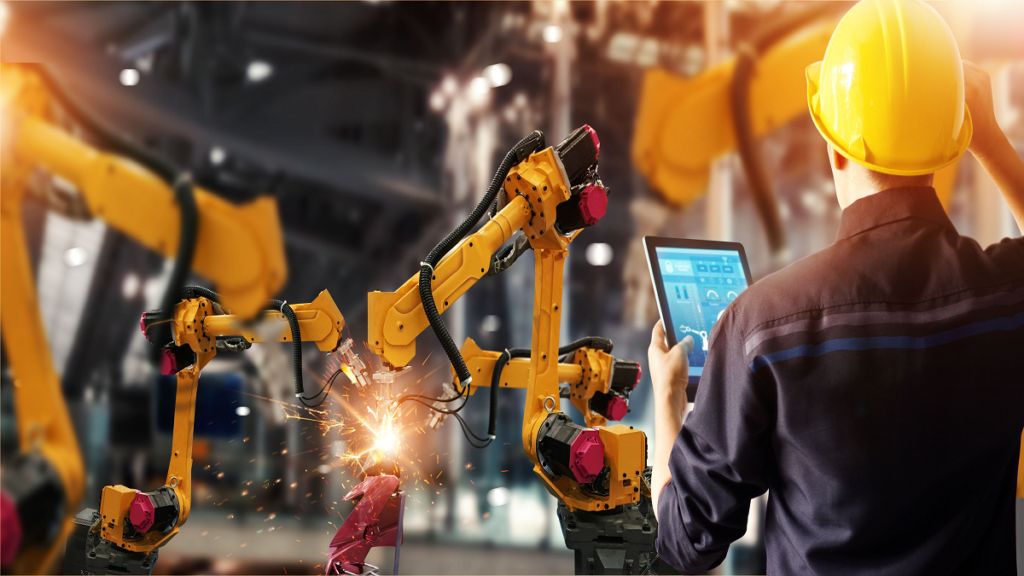Thomas Burke, Global Strategic Advisor at the CC-Link Partner Association, looks at how industrial automation vendors, machine builders and end users can future-proof robotic systems with value-adding network technologies.
The number and complexity of robotic applications is continuing to grow at a spectacular pace, helping to make digital manufacturing strategies a reality across various sectors. To succeed in the creation of highly effective and competitive robotised setups, it is important to consider how these and their constituent elements can communicate to support smart, data-driven operations.
The adoption rate of robotic solutions has accelerated to the point that installations increased by over 30% in 2021 and have more than doubled since 2015. The American market has been particularly receptive to the benefits of robotised operations in industrial settings, with nearly 35,000 new units set up across the U.S. in 2021. In this region, robots have been implemented in multiple sectors, the most common projects being in automotive, food & beverage, plastic and chemical, metal and machinery as well as electrical and electronics manufacturing.
The heightened acceptance and adoption of robotic systems in recent years has also been supported by a considerable reduction in associated capital expenditure and operational expenses. In addition to lower total cost of ownership, more intuitive and user-friendly solutions are becoming available, supporting entry-level users to begin their digitalisation.
From islands of automation to interconnected ‘e-F@ctories’
Independent of the level of automation within an organisation, in many cases, robots are installed as single, stand-alone automated systems. Commonly confined to a work cell, they can be considered ‘islands of automation’, with limited communications requirements.
However, as businesses advance in their digital transformation journey, increasingly more ambitious frameworks are being developed to create smart e-F@ctories. For example, it is possible to combine multiple automated, articulated units that work in sync on a single line or create cooperative as well as collaborative environments where humans and machines safely share the same working space.
In effect, the number of collaborative robot applications has almost quadrupled since 2017, with 39,000 new global installations in 2021.
These new, highly automated setups require an unprecedented level of interconnectivity between machines as well as with other automation components, control systems and users. Technologies including cameras, sensors and other vision systems, supervisory control and data acquisition as well as condition monitoring platforms need to seamlessly communicate.
These elements are key, for example, when several industrial robots are running in parallel and their movements need to be coordinated to ensure that operations run smoothly and potential collisions are detected and avoided, especially in confined spaces. Similarly, cooperative or collaborative robots need to be able to reduce their speed or come to an immediate halt depending on the movement and proximity of operators.
In addition, to support digital manufacturing applications, the ability to share data across the shop floor and the enterprise offers a competitive edge by improving flexibility, reliability and responsiveness. For example, ever more accurate maintenance strategies rely on data from robots and their parts to monitor their status, wear and tear as well as prevent equipment failure by means of predictive analytics.
The right communications technology for robot connectivity
These requirements can be addressed solely by enabling highly effective communications, connecting all relevant elements together to share key data and ultimately supporting coordinated activities as well as the creation of value-adding business intelligence. More specifically, it is extremely important for robots, their components and the overall network infrastructure to be able to support TSN standards, as these enable the reliable transfer of multiple types of data and traffic.
In effect, this innovation is an enhancement to standard industrial Ethernet that is intended to drive convergence and interconnectivity. Network technologies with TSN functions, such as CC-Link IE TSN, can simultaneously handle time-critical messages, e.g. dealing with robot motion control, as well as TCP/IP packets, such as videos from cameras and other vision systems.
This is achieved by scheduling data traffic queues and prioritizing the most urgent frames, while less-transient messages are sent when sufficient bandwidth is available.
Besides opening the door to convergent communications, which are at the core of IIoT applications, where IT and operational technology can merge, these capabilities offer a number of benefits to robot users. They can simplify network configurations and architectures, reducing costs while improving immediate diagnostics and troubleshooting activities. In addition, they can enhance the overall performance and productivity of machines and shop floors.
Supporting the creation of TSN-compliant robots
To enable the realization of e-F@ctories that leverage the full potential of robots on their shop floors, different players should look at how they can incorporate TSN. While end users, machine builders and system integrators should favour solutions that are compatible with this technology to improve productivity, industrial automation vendors should incorporate it into their products to open up enhanced performance opportunities.
As TSN is a relatively new addition to industrial Ethernet, robot vendors may be wondering if the time is right to adopt it. In effect, the number of robots, controllers and other devices is continuing to increase. Therefore, offering compatible, future-proof solutions is a safe bet to support market demands and enhance competitiveness.
The creation of robots and other automation components with TSN functions should leverage the most suitable development tools available, which ultimately depend on the network technology selected. For example, CC-Link IE TSN provides a broad ecosystem, characterised by multiple hardware- and software-based solutions, to help developers select and deploy what works best for their intended applications and customer needs.
There’s also plenty of other Communications editorial at IoT Insider’s sister publication, Electronic Specifier. And you can always add to the discussion at our comments section below or on our LinkedIn page here.
